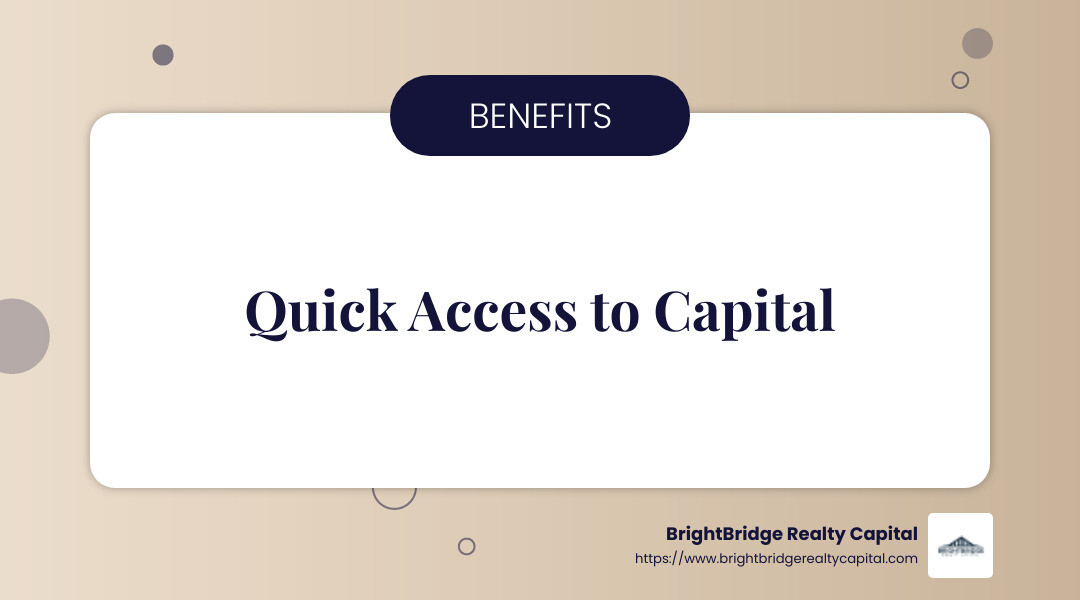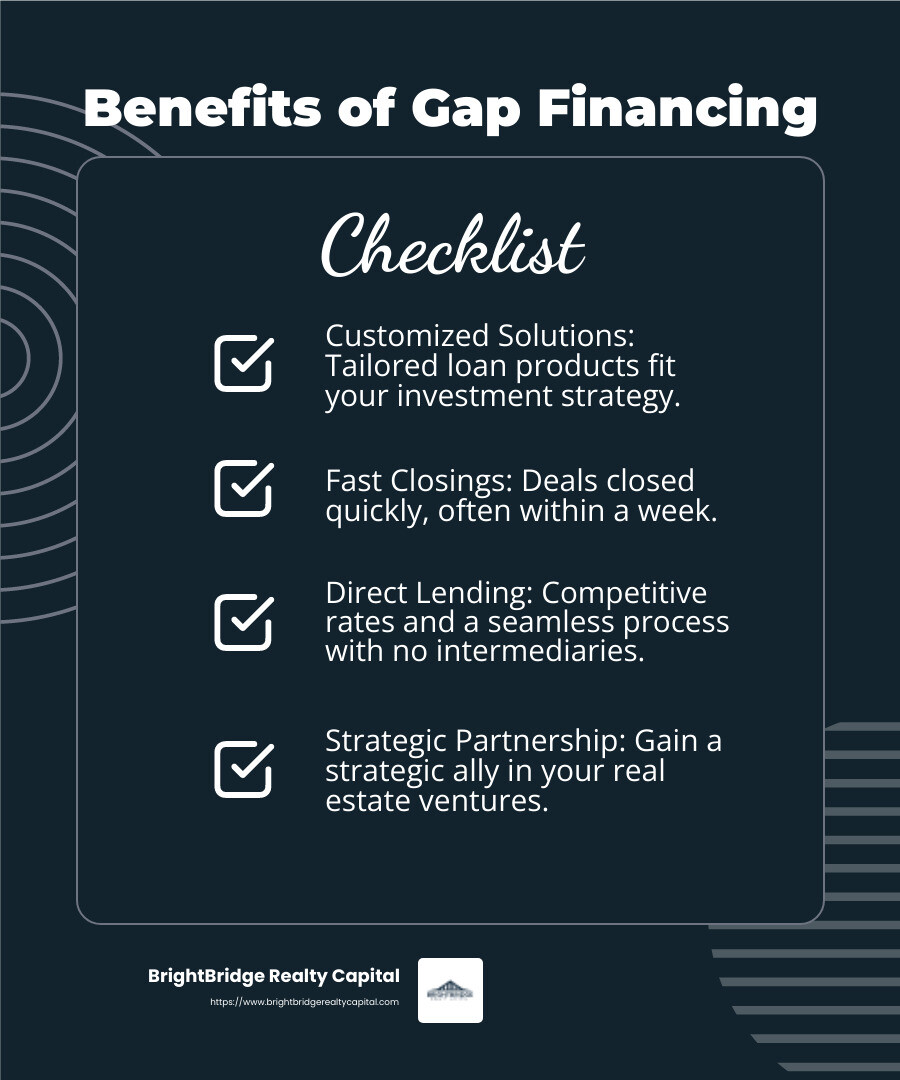Gap Financing Uncovered: A Real Estate Investor's Guide

Gap financing for real estate investors is a crucial strategy to open up lucrative investment opportunities without being hampered by financial constraints. Whether you're expanding a rental portfolio or flipping a property, this type of funding bridges the financial void that traditional loans may leave behind.
- What is it? Gap financing fills the gap between the project cost and the senior loan amount.
- Why use it? It open ups potential profits by providing the funds needed to complete a project.
- Who benefits? Investors seeking quick access to capital for timely opportunities.
Navigating real estate often involves finding inventive ways to finance projects. Gap financing stands out as a flexible tool, helping investors close deals swiftly and efficiently. By understanding the essentials of gap financing, you can position yourself to take advantage of promising real estate ventures.

Key terms for gap financing for real estate investors:
- creative financing for real estate investors
- real estate funding process
- real estate investor financing
Understanding Gap Financing
Gap financing is a handy tool for real estate investors looking to bridge the shortfall between a primary loan and the total cost of a project. Often referred to as bridge loans, these loans are designed to fill the financial gap that might otherwise prevent an investor from completing a deal.
What is Gap Financing?
Gap financing is a type of private loan that steps in where traditional loans fall short. It's used to cover additional expenses like renovations, marketing, and other costs associated with flipping or managing properties.
For example, if a hard money loan covers 70% of a project's cost, gap financing can provide the remaining funds needed to move forward. This ensures the investor can complete the project without waiting for funds from other sources.
Why Use Gap Financing?
Investors often face situations where time is crucial. Traditional bank loans can take months to approve, making them impractical for fast-moving opportunities. Gap financing offers a quicker alternative, allowing investors to seize opportunities without delay.

How Does Gap Financing Work?
Gap financing typically involves higher interest rates due to the increased risk for lenders. The hard money lender holds the primary lien, while the gap lender takes a secondary position. This means that in a foreclosure, the gap lender is paid after the primary lender, which increases their risk.
Despite the higher cost, the speed and flexibility of gap financing make it an attractive option for investors who need to act quickly.
Who Benefits from Gap Financing?
Both novice and seasoned investors can benefit from gap financing. For those with capital tied up in other projects, it allows them to continue investing without waiting for current projects to complete.
Investors who understand how to leverage this type of financing can maximize their real estate opportunities and potentially increase their returns.
By mastering the ins and outs of gap financing, real estate investors can position themselves to capitalize on promising ventures that might otherwise be out of reach.
Next, let's dig into the benefits and drawbacks of gap financing for real estate investors, exploring how it can lead to high returns but also involves certain risks.
Benefits and Drawbacks of Gap Financing for Real Estate Investors
Gap financing for real estate investors offers a mix of high rewards and notable risks. Let's explore these aspects to help you decide if it's the right move for your investment strategy.
Benefits: High Returns and Quick Turnaround
One of the most appealing advantages of gap financing is the potential for high returns. By filling the financial gap between a primary loan and the total project cost, investors can take on more significant projects that promise greater profits. For instance, using gap funds to complete a high-end renovation can lead to substantial gains when the property is sold.
Moreover, quick access to funds is a game-changer in the competitive real estate market. Traditional loans can be slow, but gap financing is typically fast, often closing within days. This speed allows investors to jump on time-sensitive opportunities before others do.
Drawbacks: Risks and Costs
However, the benefits come with their share of risks. Gap financing is not for the faint-hearted. Lenders face increased risk, so they often charge higher interest rates compared to traditional loans. According to industry insights, interest rates can range from 3.25% to 10.5%, depending on the borrower's creditworthiness.
Additionally, gap financing is not ideal for one-off projects. It's best suited for investors managing multiple properties, as the costs can add up. Lenders might also require a share of the sale proceeds, further eating into your profits.
Borrowers should also be prepared for additional fees, such as appraisal, notary, and loan origination fees. These can increase the overall cost of the loan, making it crucial for investors to weigh the potential returns against these expenses.
Risks of Delayed Projects
Another risk is project delays, which can lead to accumulating interest payments and reduced liquidity. If a project takes longer than expected to sell, investors might find themselves stretched thin financially. This is why gap financing is often reserved for experienced investors who can manage these complexities effectively.
In summary, while gap financing for real estate investors offers the lure of high returns and quick deals, consider the associated risks and costs. Investors should thoroughly evaluate their financial situation and project timelines before diving in.
Next, we'll explore how to secure gap financing and the options available to investors looking to leverage this powerful tool.
How to Secure Gap Financing
Securing gap financing for real estate investors can be a strategic move to bridge the financial gap in your projects. Let's explore the options available and how you can access this type of funding.
Traditional Banks
While traditional banks are a common source for real estate loans, they are not typically the go-to for gap financing. Banks often prefer long-term, secured loans and may not offer the flexibility or speed that gap financing demands. However, if you have a strong relationship with your bank, it might be worth discussing your needs as they might offer some customized solutions.
Private Lenders
Private lenders are a popular choice for gap financing. They can offer more flexible terms and faster access to funds compared to traditional banks. This speed is crucial in the real estate market where opportunities can quickly vanish. Private lenders are also more likely to understand the nuances of real estate investing and may be open to negotiating terms that align with your project's needs.
Pro Tip: When working with private lenders, clearly understand their terms. Interest rates are typically higher than those of traditional loans, and lenders may require a portion of the profits upon sale. Ensure you have a detailed plan to manage these costs.
Asset-Based Loans
Asset-based loans are another avenue for securing gap financing. These loans are secured by the asset itself, meaning the property you are investing in serves as collateral. This can be advantageous if you lack the credit history or cash reserves that traditional loans often require.
Asset-based loans can provide the liquidity needed to move forward with a project quickly. However, they come with their own risks. If the project does not go as planned, you risk losing the asset. Therefore, it's crucial to have a solid exit strategy and contingency plans in place.
Key Takeaways
- Explore All Options: Before deciding on a lender, explore all available options to find the best terms for your project.
- Understand the Costs: Be aware of the interest rates and fees associated with gap financing. These can impact your project's profitability.
- Have a Plan: Whether securing funds from private lenders or through asset-based loans, a detailed plan can help mitigate risks and ensure a smooth financing process.
By understanding and leveraging the right financing options, you can effectively secure the gap financing needed to propel your real estate ventures forward.
Next, we'll discuss when to use gap financing and the scenarios where it can be most beneficial for investors.
When to Use Gap Financing
Gap financing can be a powerful tool for real estate investors, but knowing when to use it is key. Let's explore some scenarios where gap financing for real estate investors can make all the difference.
High-End Projects
High-end real estate projects often require significant upfront capital. These projects can yield substantial returns, but the initial costs can be daunting. Gap financing helps investors cover these costs without tying up their own capital. This allows investors to seize lucrative opportunities they might otherwise miss.
For instance, imagine an investor eyeing a luxury property in New York. The property promises a high return but requires a hefty initial investment. With gap financing, the investor can secure the property quickly while arranging for long-term financing or waiting for the property to sell.
Liquidity
Maintaining liquidity is crucial for any investor, especially in real estate. Gap financing provides the flexibility to keep cash reserves intact. This is particularly important when managing multiple projects simultaneously. It allows investors to respond quickly to new opportunities or unexpected expenses.
Consider an investor managing several fix-and-flip projects. A sudden market opportunity arises, but the investor's funds are tied up in ongoing projects. Gap financing can bridge this gap, providing the necessary liquidity to capitalize on the new opportunity without disrupting existing projects.
Unfinished Projects
Unfinished projects can be a headache for real estate investors. Whether due to unexpected delays or cost overruns, these situations can stall progress and drain resources. Gap financing can provide the necessary funds to complete these projects, ensuring they move forward without delay.
For example, an investor might face unexpected construction costs that exceed the initial budget. Without additional funding, the project stalls, and potential profits are at risk. Gap financing can cover the shortfall, keeping the project on track and protecting the investor's investment.
By understanding these scenarios, investors can strategically use gap financing to improve their real estate ventures. Next, we'll answer some frequently asked questions about gap financing for real estate investors.
Frequently Asked Questions about Gap Financing for Real Estate Investors
What is gap funding?
Gap funding is a type of financial support that helps bridge the shortfall between the funds a real estate investor currently has and the total amount needed to complete a project. It's particularly useful for covering the difference between a hard money loan and the actual acquisition costs or for funding additional expenses like renovations or incidentals.
Unlike traditional loans, gap funding is often a private loan. This means it comes from private lenders rather than banks, offering more flexibility and faster access to funds. Investors use gap funding to quickly close deals, especially in competitive markets where time is of the essence.
How does gap financing differ from traditional loans?
Gap financing differs from traditional loans in several key ways:
Speed: While traditional mortgages can take months to secure, gap financing offers quick access to cash, often within days. This speed is crucial for investors looking to seize time-sensitive opportunities.
Flexibility: Traditional loans come with rigid terms and extensive paperwork. Gap financing, on the other hand, offers more flexible terms custom to the investor's needs.
Purpose: Traditional mortgages are primarily for property acquisition. Gap financing can be used for a variety of purposes, including covering rehab costs, bridging short-term financing needs, and maintaining liquidity.
Why is gap financing necessary for real estate investors?
Investment opportunities in real estate often require swift action. In a competitive market, the ability to move quickly can make or break a deal. Gap financing provides the necessary funds to act on these opportunities without delay.
Additionally, gap financing supports a quick turnaround on projects. Investors can complete renovations or developments faster, allowing them to sell or refinance properties promptly. This speed not only maximizes returns but also reduces holding costs and interest payments.
Gap financing empowers real estate investors to stay agile, maintain liquidity, and capitalize on lucrative opportunities that might otherwise be out of reach. By understanding and leveraging gap financing, investors can improve their strategies and achieve their real estate goals more effectively.
Next, we'll dig into how to secure gap financing and explore the options available for real estate investors.
Conclusion
Gap financing is an invaluable tool for real estate investors who need quick, flexible funding solutions. At BrightBridge Realty Capital, we specialize in providing customized financing options that cater to the unique needs of each investor. Our expertise in the real estate sector, combined with our commitment to fast closings, sets us apart from traditional lenders.
Why choose BrightBridge Realty Capital?
Customized Solutions: We tailor our loan products to fit your specific investment strategy, whether you're flipping properties, developing new projects, or expanding your rental portfolio. Our team understands that every investor's needs are different, and we're here to provide the right financial support.
Fast Closings: Time is often a critical factor in real estate investment. That's why we pride ourselves on our ability to close deals quickly, often within a week. This speed ensures that you can seize opportunities as they arise, without getting bogged down by lengthy approval processes.
Direct Lending: With no intermediaries, we offer competitive rates and a seamless process. Our direct lending approach ensures that you get the best terms possible, without unnecessary complications or delays.
By partnering with us, you're not just getting a loan; you're gaining a strategic ally in your real estate ventures. Our nationwide reach and deep industry knowledge make us the ideal partner for investors looking to maximize their returns and achieve their goals.
For more information on how we can help you with gap financing for real estate investors, visit our BrightBridge Realty Capital page and find how our custom solutions can propel your real estate investments forward.



